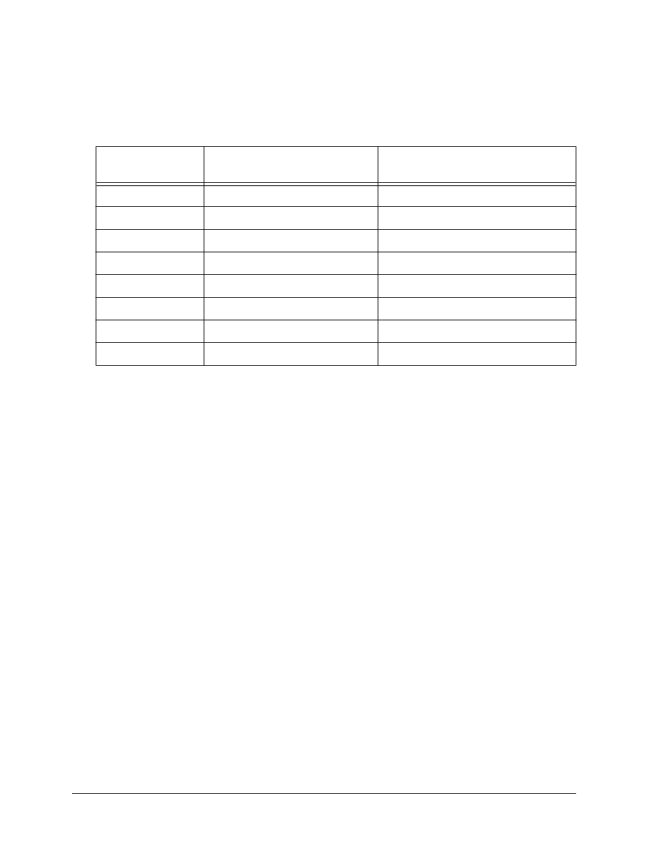- 您现在的位置:买卖IC网 > Sheet目录308 > ADZS-21479-EZLITE (Analog Devices Inc)KIT EVAL EZ BOARD ADSP-2147X

Push Buttons and Switches
Audio In2 Left Selection Switch (SW18)
connected to the AD1939’s ADC3 circuit, to either the single-ended RCA
connectors or the differential DB25 connector. By default, the switch is
set up to use the RCA connectors for audio in. To use the standard, off
the shelf DB25 connector to XLR cables, change the switch to the differ-
ential setting. See Table 2-15 . For more information, see “Differential
In/Out Connectors (P8–9)” on page 2-28.
Table 2-15. Audio In2 Left Selection Switch (SW18)
SW18 Position
SW18.1
SW18.2
SW18.3
SW18.4
SW18.5
SW18.6
Single Ended RCA IN (Default)
ON
OFF
ON
OFF
ON
OFF
Differential DB25 IN (P8)
OFF
ON
OFF
ON
OFF
ON
JTAG Switches (SW19 –22)
The JTAG switches ( SW19 , SW20 , SW21 , and SW22 ) select between a sin-
gle-processor (one EZ-Board) and multi-processor (more than one
EZ-Board) configurations. By default, the four DIP switches are set up for
a single EZ-Board configuration. See Table 2-16 .
The default configuration applies to either a debug agent or an external
emulator, such as the Analog Devices high-performance USB-based emu-
lator (HP-USB ICE for short). To use an external emulator and multiple
EZ-Boards simultaneously in one VisualDSP++ multi-processor session,
set up the boards as shown in Table 2-17 . Attach the boards to each other
via connectors J3 and P10 . For two EZ-Boards, no external cables are
required. For three or more EZ-Boards, obtain Samtec JTAG cables
2-16
ADSP-21479 EZ-Board Evaluation System Manual
发布紧急采购,3分钟左右您将得到回复。
相关PDF资料
ADZS-21489-EZLITE
KIT EVAL EZ BOARD ADSP-2148X
ADZS-218X-ICE-2.5V
EMULATOR SRL FOR ADDS-218X-ICE
ADZS-BF506F-EZLITE
KIT EVAL EZLITE ADSP-BF506F
ADZS-BF518F-EZLITE
KIT EZ LITE BF512F/14F/16F/18F
ADZS-BF527-EZLITE
BOARD EVAL ADSP-BF527
ADZS-BF533-EZLITE
KIT W/BOARD EVAL FOR ADSP-BF533
ADZS-BF538F-EZLITE
BOARD EVAL FOR ADSP-BF538
ADZS-BF561-EZLITE
BOARD EVAL ADSP-BF561
相关代理商/技术参数
ADZS-21489-EZBRD
功能描述:BOARD EVAL FOR ADZS-2148X RoHS:是 类别:编程器,开发系统 >> 通用嵌入式开发板和套件(MCU、DSP、FPGA、CPLD等) 系列:SHARC® 产品培训模块:Blackfin® Processor Core Architecture Overview
Blackfin® Device Drivers
Blackfin® Optimizations for Performance and Power Consumption
Blackfin® System Services 特色产品:Blackfin? BF50x Series Processors 标准包装:1 系列:Blackfin® 类型:DSP 适用于相关产品:ADSP-BF548 所含物品:板,软件,4x4 键盘,光学拨轮,QVGA 触摸屏 LCD 和 40G 硬盘 配用:ADZS-BFBLUET-EZEXT-ND - EZ-EXTENDER DAUGHTERBOARDADZS-BFLLCD-EZEXT-ND - BOARD EXT LANDSCAP LCD INTERFACE 相关产品:ADSP-BF542BBCZ-4A-ND - IC DSP 16BIT 400MHZ 400CSBGAADSP-BF544MBBCZ-5M-ND - IC DSP 16BIT 533MHZ MDDR 400CBGAADSP-BF542MBBCZ-5M-ND - IC DSP 16BIT 533MHZ MDDR 400CBGAADSP-BF542KBCZ-6A-ND - IC DSP 16BIT 600MHZ 400CSBGAADSP-BF547MBBCZ-5M-ND - IC DSP 16BIT 533MHZ MDDR 400CBGAADSP-BF548BBCZ-5A-ND - IC DSP 16BIT 533MHZ 400CSBGAADSP-BF547BBCZ-5A-ND - IC DSP 16BIT 533MHZ 400CSBGAADSP-BF544BBCZ-5A-ND - IC DSP 16BIT 533MHZ 400CSBGAADSP-BF542BBCZ-5A-ND - IC DSP 16BIT 533MHZ 400CSBGA
ADZS-21489-EZBRD
制造商:Analog Devices 功能描述:EZ BOARD SUPPORTING SHARC 21489
ADZS-21489-EZLITE
功能描述:KIT EVAL EZ BOARD ADSP-2148X RoHS:是 类别:编程器,开发系统 >> 通用嵌入式开发板和套件(MCU、DSP、FPGA、CPLD等) 系列:SHARC® 产品培训模块:Blackfin® Processor Core Architecture Overview
Blackfin® Device Drivers
Blackfin® Optimizations for Performance and Power Consumption
Blackfin® System Services 特色产品:Blackfin? BF50x Series Processors 标准包装:1 系列:Blackfin® 类型:DSP 适用于相关产品:ADSP-BF548 所含物品:板,软件,4x4 键盘,光学拨轮,QVGA 触摸屏 LCD 和 40G 硬盘 配用:ADZS-BFBLUET-EZEXT-ND - EZ-EXTENDER DAUGHTERBOARDADZS-BFLLCD-EZEXT-ND - BOARD EXT LANDSCAP LCD INTERFACE 相关产品:ADSP-BF542BBCZ-4A-ND - IC DSP 16BIT 400MHZ 400CSBGAADSP-BF544MBBCZ-5M-ND - IC DSP 16BIT 533MHZ MDDR 400CBGAADSP-BF542MBBCZ-5M-ND - IC DSP 16BIT 533MHZ MDDR 400CBGAADSP-BF542KBCZ-6A-ND - IC DSP 16BIT 600MHZ 400CSBGAADSP-BF547MBBCZ-5M-ND - IC DSP 16BIT 533MHZ MDDR 400CBGAADSP-BF548BBCZ-5A-ND - IC DSP 16BIT 533MHZ 400CSBGAADSP-BF547BBCZ-5A-ND - IC DSP 16BIT 533MHZ 400CSBGAADSP-BF544BBCZ-5A-ND - IC DSP 16BIT 533MHZ 400CSBGAADSP-BF542BBCZ-5A-ND - IC DSP 16BIT 533MHZ 400CSBGA
ADZS-2189M-EZLITE
功能描述:开发板和工具包 - 其他处理器 ADZS-2189M-EZLITE
RoHS:否 制造商:Freescale Semiconductor 产品:Development Systems 工具用于评估:P3041 核心:e500mc 接口类型:I2C, SPI, USB 工作电源电压:
ADZS-218X-ICE-2.5V
功能描述:EMULATOR SRL FOR ADDS-218X-ICE RoHS:是 类别:编程器,开发系统 >> 内电路编程器、仿真器以及调试器 系列:EZ-ICE® 产品变化通告:Development Systems Discontinuation 19/Jul/2010 标准包装:1 系列:* 类型:* 适用于相关产品:* 所含物品:*
ADZS22105
功能描述:RELAY GEN PURPOSE SPST 90A 5V 制造商:panasonic electric works 系列:ADZS 包装:托盘 零件状态:在售 继电器类型:通用 线圈类型:锁存,双线圈 线圈电流:600mA 线圈电压:5VDC 触头外形:SPST-NO(1 A 型) 额定接触(电流):90A 开关电压:276VAC - 最大 导通电压(最大值):3.5 VDC 关闭电压(最小值):- 工作时间:20ms 释放时间:20ms 特性:- 安装类型:底座安装 端子类型:螺丝端子 工作温度:-40°C ~ 85°C 触头材料:银锡氧化物(AgSnO) 线圈功率:3 W 线圈电阻:8.3 Ohms 标准包装:20
ADZS22112
功能描述:RELAY GEN PURPOSE SPST 90A 12V 制造商:panasonic electric works 系列:ADZS 包装:托盘 零件状态:在售 继电器类型:通用 线圈类型:锁存,双线圈 线圈电流:250mA 线圈电压:12VDC 触头外形:SPST-NO(1 A 型) 额定接触(电流):90A 开关电压:276VAC - 最大 导通电压(最大值):8.4 VDC 关闭电压(最小值):- 工作时间:20ms 释放时间:20ms 特性:- 安装类型:底座安装 端子类型:螺丝端子 工作温度:-40°C ~ 85°C 触头材料:银锡氧化物(AgSnO) 线圈功率:3 W 线圈电阻:48 Ohms 标准包装:20
ADZS22124
功能描述:RELAY GEN PURPOSE SPST 90A 24V 制造商:panasonic electric works 系列:ADZS 包装:托盘 零件状态:在售 继电器类型:通用 线圈类型:锁存,双线圈 线圈电流:125mA 线圈电压:24VDC 触头外形:SPST-NO(1 A 型) 额定接触(电流):90A 开关电压:276VAC - 最大 导通电压(最大值):16.8 VDC 关闭电压(最小值):- 工作时间:20ms 释放时间:20ms 特性:- 安装类型:底座安装 端子类型:螺丝端子 工作温度:-40°C ~ 85°C 触头材料:银锡氧化物(AgSnO) 线圈功率:3 W 线圈电阻:192 Ohms 标准包装:20
